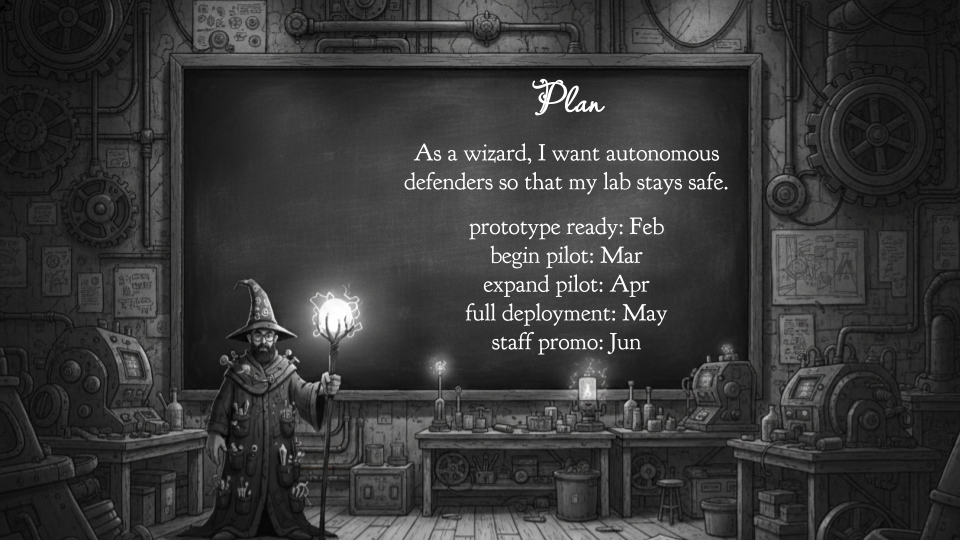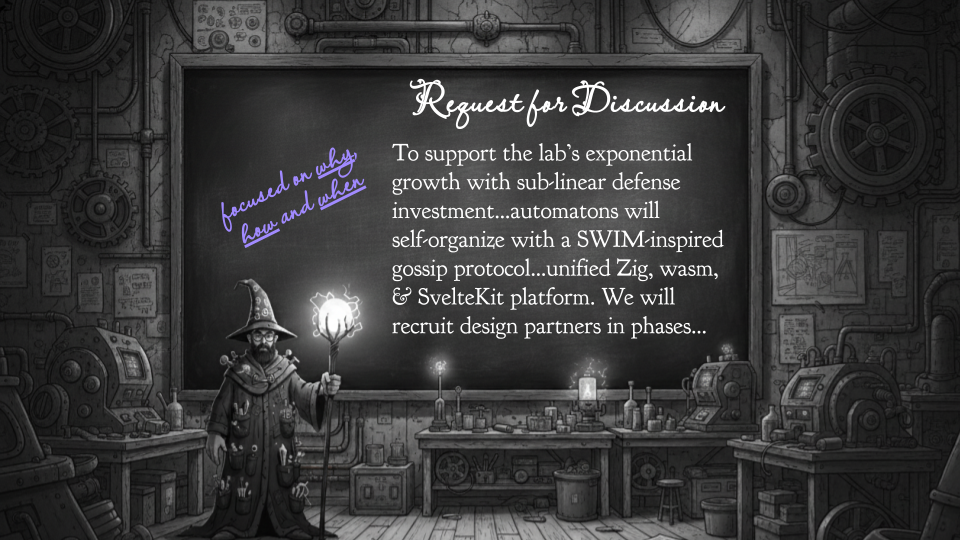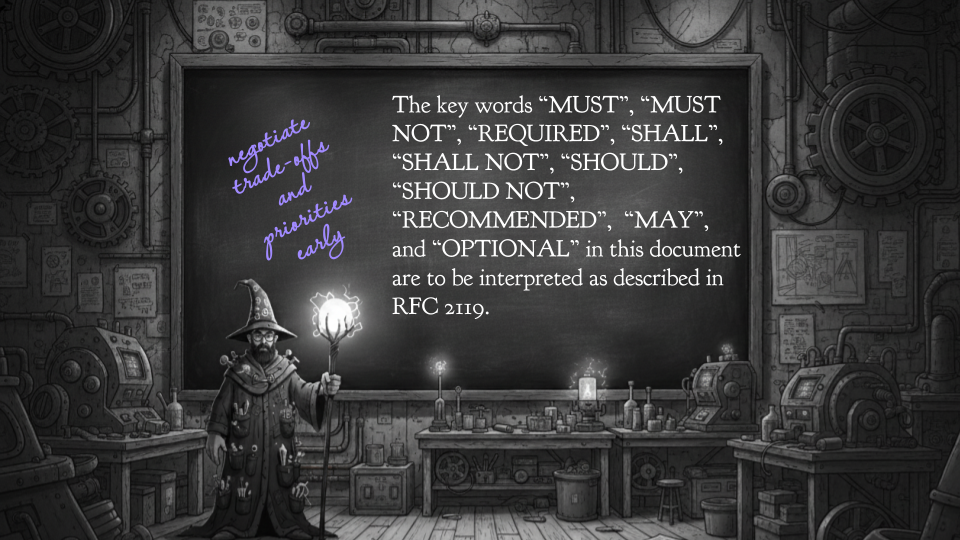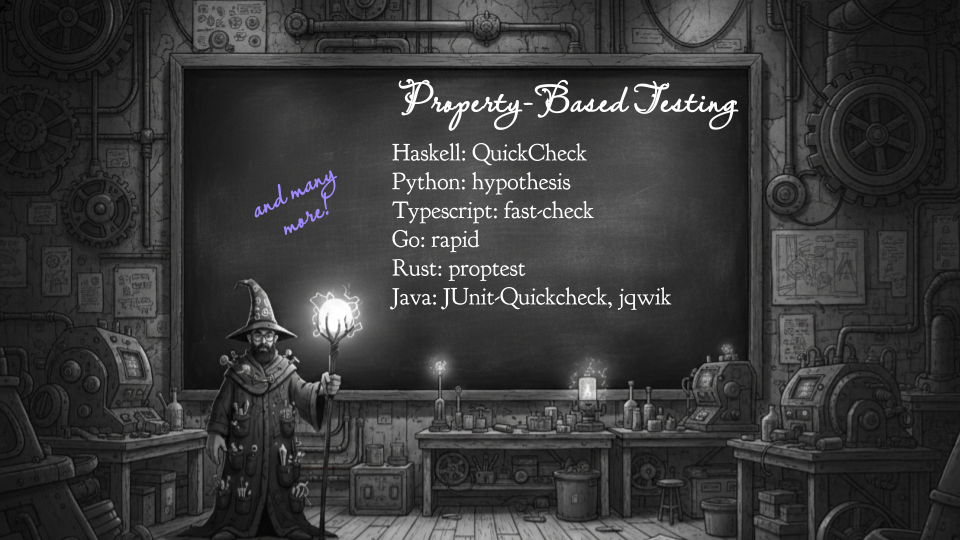Oct 2025

This fall, I spoke at LeadDev about property-based testing — but I camouflaged all the Haskell in a story about well-intentioned wizards and murderous steampunk robots. It went well! There’s a nice video of the talk and a PDF of my slides available on the LeadDev website.
Unfortunately, the video and PDF are behind a registration wall. The LeadDev folks put on an excellent conference, so I don’t begrudge them the opportunity to grow their community. But if you’d rather stay anonymous, here’s a version of my slides annotated with a slightly cleaned-up transcript of the talk.

Welcome to Build Bravely, in which we’ll see how two bangers from the 90s can help us deliver risky projects on time, on spec, and not on fire.

I’m Akshay, and I’ve been an infra and platform engineer for about 15 years. I’ve worked at other people’s silly startups, my own silly startup, Uber, and Microsoft. These days, I’m the Field CTO at Antithesis.
This is Gemini’s portrayal of me as a wizard. The shell-shocked look on my face is spot-on, because I’ve spent most of my career fixing horrifyingly broken software. I’m now middle-aged, a bit grumpy, and a lot skeptical. I am not usually brave. I am not into the big-bang rewrite.

I prefer gradual improvement. I like local maxima. But sometimes, requirements change, the business grows, the unexpected arrives, and we are grudgingly forced to build something completely new. Something risky. Something a bit brave.

Every brave project begins with a plan. Often, a humble user story: “as a wizard, I want autonomous defenders so I can stay in my lab and not talk to anyone.” And of course, our brave project comes with milestones, culminating in my triumphant staff promotion.

Maybe we’re a bit more formal, and our projects start with plans like this. But whether they’re long or short, our plans tend to focus on three things: why, how, and when. These are good questions to answer. But even when the plan is really good, and really aligned with our engineering strategy, all of you reading it feel this creeping sense of doom.
Yeah, you can quibble with the details here. Will our investment really be sub-linear? Is a gossip protocol the right choice? How did Svelte even become involved? But quibbling doesn’t change the most likely outcome...

...which is complete and utter disaster. Our project will almost certainly be late. It will solve only part of the problem. After all the delays and thrashing, half the team will quit or transfer. And then, just as the robot automatons are murdering all of us, we’ll realize that we have drifted ever so slightly off-spec.
Yikes. How did we go so wrong?

Well, we treated our ambitious project like it was going to be a casual weekend hike — when in fact it’s an expedition into a blasted hellscape littered with the bodies of our peers.
Yeah, we planned the how and the when. The route and the itinerary. We read Will Larson’s books. We followed all the best practices. But we didn’t spend enough time describing the destination. We didn’t specify our new system carefully enough and early enough, so we spent a lot of time thrashing and — oops! — built robots that turned out to be murder hobos.
So what does a good up-front spec look like?

I don’t know, but I am familiar with one kind of spec — the basic integration test. This is a critical test that we obviously forgot to write: the robots should not murder us.

But wait! To be really thorough, we also need a test with two robots, in a forest, with a slightly different command. But this is just the tip of the iceberg.

There are so many possible situations. We need a whole suite of integration tests. And they’re probably going to end up outweighing the implementation. We need a QA team, or an SDET team — this cannot be our problem.
And deep inside, we all know that this is a complete sham. Even with all of this, we’ve only tested the tiniest fraction of the possible states that our code could be in. And we have burned tons of engineering time on this. Whole teams have been hired just to write and maintain test suites like this one. When the spec changes, we have to amend all of this code.
So far from giving us wings, all of this is just weighing us down. And worst of all, these specs are very bad at communicating intent. Rather than explicitly stating the primary constraint — our creations should not rise up and kill us — they’re just hinting at it, over and over and over again. They’re asking everyone on our team to mentally compile this series of examples down into the main point.
This kind of test is not worth the effort.

The root of the problem is that the test suite — this spec — is mired in trivial details. One robot. In the lab. One wizard. One specific command. It sounds like we’re playing Clue! Ideally, we would condense all of this into one much more general test.

That all-encompassing test might look like this. Any number of robots. Any place. Any number of wizards. Any phrase at all. Aha! Now we need fewer tests — maybe just this one! — and we are clearly and explicitly communicating intent. Rather than a test, we might call this a property.

We’ve also made evolution easier. Remember, I’m suggesting that we write this property — this spec — really early in the planning cycle, maybe even before we’ve written any code. As we talk to our users, we’re going to discover even more requirements. And when we do, it’s easy to extend our properties.
And as we extend our properties, we’re forced to be very clear: are these new requirements really required, or are they just recommendations, or even just nice-to-haves? If an engineer or an LLM on my team wants to amend this property, their intention is very clear. If we weaken “must not murder” to “should not murder,” that’s an extremely large red flag that’s very easy to catch.
Of course, if you’re listening carefully, all of this “must” and “should” and “may” is starting to ring a bell.

It’s all starting to sound a bit like RFC 2119, the number one banger of 1997! In two pages, this RFC defines the terminology for requirement levels, which is a really simple, powerful idea: we should distinguish between absolute requirements, recommendations, and nice-to-haves. Thinking this way forces us to navigate tradeoffs and competing priorities very early.
So now we’ve got this RFC-like property, which is strong, and short, and still manages to be nuanced, but it has the same weakness as internet RFCs. It’s not executable.

Or at least it wasn’t until 1999, when QuickCheck was released. QuickCheck takes properties like ours, and it generates input data, and then it checks that the properties still hold.

You can think of that like our robot defense system running in multiple parallel universes, with different numbers of robots, different locations, different enemies, and different commands. QuickCheck is generating thousands of these universes and verifying that our robots never rise up in rebellion.
This is called property-based testing, and it is phenomenally effective. In a recent study of 40 Python projects on Github, a couple of researchers discovered that property-based tests are fifty times more effective at catching bugs than standard tests. (At the conference, I misspoke and said that the study looked at 400 projects. Oops!)

Unfortunately, QuickCheck was written in Haskell, so only seven people in the world cared — and all of them were busy writing the Haskell compiler. But over the next 25 years, we were able to decrypt these tomes of wisdom and translate them into all the languages that all of us actually use. So now, no matter what language you work in, you have a really good PBT library available to you.
Every project benefits from this style of verification. It’s simple. It’s easy. I promise, it doesn’t hurt.

And that’s my pitch to you. Use the language of RFC 2119. Use property-based testing. And write specs for your software early — ideally during planning, when you’re already thinking about prioritization and tradeoffs. And then, for the life of your project, your team has jet fuel. You can evolve your code rapidly — with humans, with agents, with whomever you like. Because you have a powerful, understandable test suite that keeps your project aligned with the original plan. For sure. Guaranteed!

And that’s it! Special thanks to Scott Bradner, who wrote RFC 2119, to John Hughes and every other contributor to QuickCheck, and all the folks pushing PBT forwards. And with that, thank you for your attention.